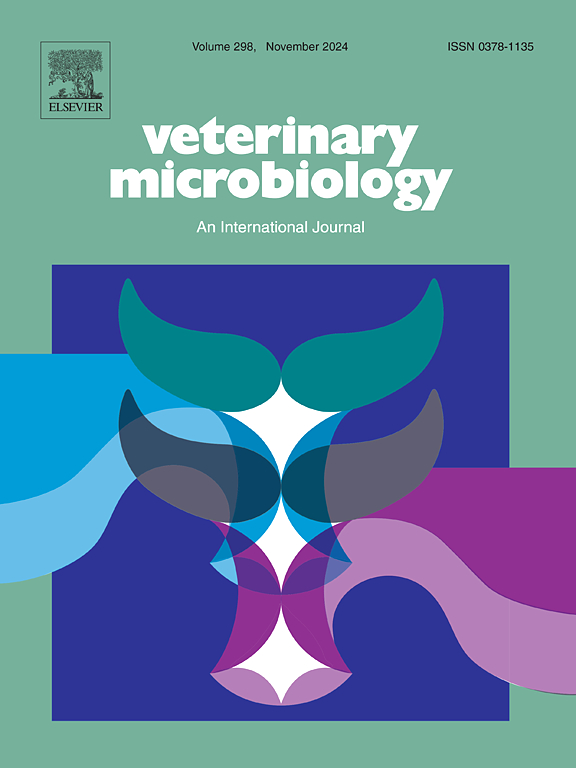加入 U-OMP19 的新型口服狂犬病灭活疫苗在小鼠模型中通过减少病毒蛋白降解和激活树突状细胞增强了免疫原性。
IF 2.4
2区 农林科学
Q3 MICROBIOLOGY
引用次数: 0
摘要
目前,狗(尤其是流浪狗)和/或野生动物是狂犬病的主要传播源,而口服疫苗是控制这些动物感染狂犬病的最实用方法。安全性和有效性是开发口服疫苗的两个关键标准。关于口服疫苗的有效性,免疫原被胃肠液降解是一个主要挑战,导致疫苗接种后的免疫反应不理想。出于安全考虑,灭活疫苗是最佳选择。在本研究中,我们构建并挽救了一种重组狂犬病病毒(RABV),在 RABV 病毒中加入了布鲁氏菌的非脂质外膜蛋白 19(U-OMP19),命名为 LBNSE-OMP19-G。我们发现,将 U-OMP19 加入 LBNSE-OMP19-G 病毒中,可以保护 RABV G 蛋白不被体外胃肠液消化。此外,我们还评估了 LBNSE-OMP19-G 作为口服灭活疫苗的免疫原性,灭活的 LBNSE-OMP19-G 能激活更多的树突状细胞(DCs),促进滤泡辅助性 T 细胞(TFH)、生殖中心 B 细胞(GC)和浆细胞的生成、从而诱导更高水平的病毒中和抗体,并在狂犬病致死性挑战后提供更好的保护。这些数据表明,LBNSE-OMP19-G 具有良好的安全性和免疫原性,可作为一种潜在的口服狂犬病灭活疫苗候选物。本文章由计算机程序翻译,如有差异,请以英文原文为准。
A novel inactivated oral rabies vaccine with the incorporation of U-OMP19 enhances the immunogenicity by reducing viral proteins degradation and activating dendritic cells in a mouse model
Currently, dogs, especially stray dogs, and/or wild animals are the main sources of rabies transmission, and oral vaccination is the most practical way to control rabies in these animals. Safety and efficacy are two key criteria for developing oral vaccines. Concerning the efficacy of oral vaccines, degradation of immunogens by gastrointestinal fluid is a major challenge, resulting in suboptimal immune responses after vaccination. For safety reasons, inactivated vaccines are the most optimal choice. In the present study, a recombinant rabies virus (RABV) with un-lipidated outer membrane protein 19 (U-OMP19) of Brucella spp incorporated into RABV virions, designated as LBNSE-OMP19-G, was constructed and rescued. We found that U-OMP19 was incorporated into LBNSE-OMP19-G virion, which could protect RABV G protein from digestion by gastrointestinal fluids in vitro. Moreover, the immunogenicity of LBNSE-OMP19-G as an inactivated oral vaccine was evaluated, and the inactivated LBNSE-OMP19-G could activate more dendritic cells (DCs) and promote the generation of follicular helper T (TFH) cells, germinal center (GC) B cells, and plasma cells in immunized mice compared with those in mice immunized with parent virus LNBSE, which consequently induced a higher level of virus neutralizing antibody and provided better protection after a lethal challenge of rabies. These data indicate that LBNSE-OMP19-G, which has good safety and immunogenicity, could be a potential inactivated oral rabies vaccine candidate.
求助全文
通过发布文献求助,成功后即可免费获取论文全文。
去求助
来源期刊

Veterinary microbiology
农林科学-兽医学
CiteScore
5.90
自引率
6.10%
发文量
221
审稿时长
52 days
期刊介绍:
Veterinary Microbiology is concerned with microbial (bacterial, fungal, viral) diseases of domesticated vertebrate animals (livestock, companion animals, fur-bearing animals, game, poultry, fish) that supply food, other useful products or companionship. In addition, Microbial diseases of wild animals living in captivity, or as members of the feral fauna will also be considered if the infections are of interest because of their interrelation with humans (zoonoses) and/or domestic animals. Studies of antimicrobial resistance are also included, provided that the results represent a substantial advance in knowledge. Authors are strongly encouraged to read - prior to submission - the Editorials (''Scope or cope'' and ''Scope or cope II'') published previously in the journal. The Editors reserve the right to suggest submission to another journal for those papers which they feel would be more appropriate for consideration by that journal.
Original research papers of high quality and novelty on aspects of control, host response, molecular biology, pathogenesis, prevention, and treatment of microbial diseases of animals are published. Papers dealing primarily with immunology, epidemiology, molecular biology and antiviral or microbial agents will only be considered if they demonstrate a clear impact on a disease. Papers focusing solely on diagnostic techniques (such as another PCR protocol or ELISA) will not be published - focus should be on a microorganism and not on a particular technique. Papers only reporting microbial sequences, transcriptomics data, or proteomics data will not be considered unless the results represent a substantial advance in knowledge.
Drug trial papers will be considered if they have general application or significance. Papers on the identification of microorganisms will also be considered, but detailed taxonomic studies do not fall within the scope of the journal. Case reports will not be published, unless they have general application or contain novel aspects. Papers of geographically limited interest, which repeat what had been established elsewhere will not be considered. The readership of the journal is global.
 求助内容:
求助内容: 应助结果提醒方式:
应助结果提醒方式:


